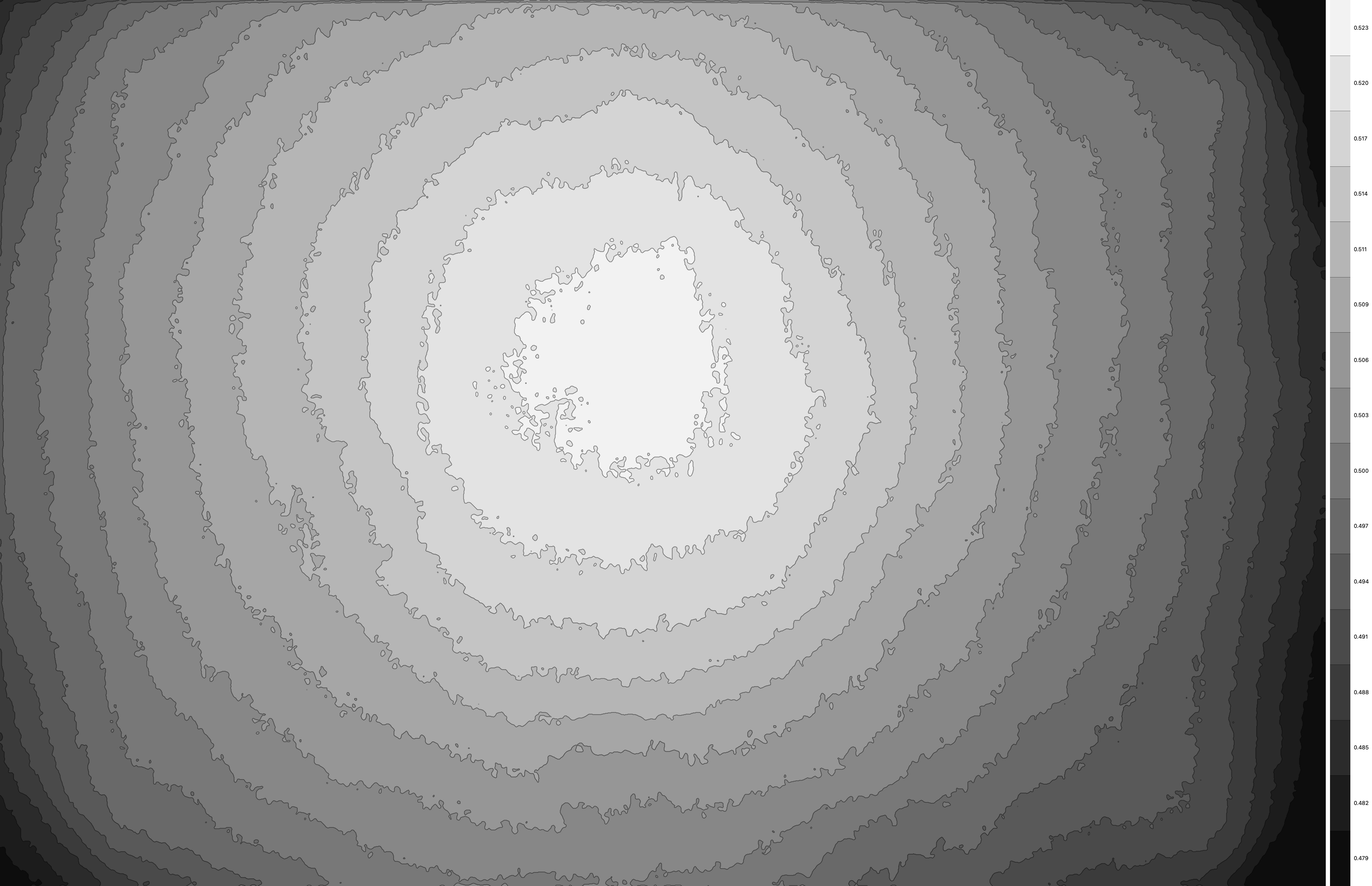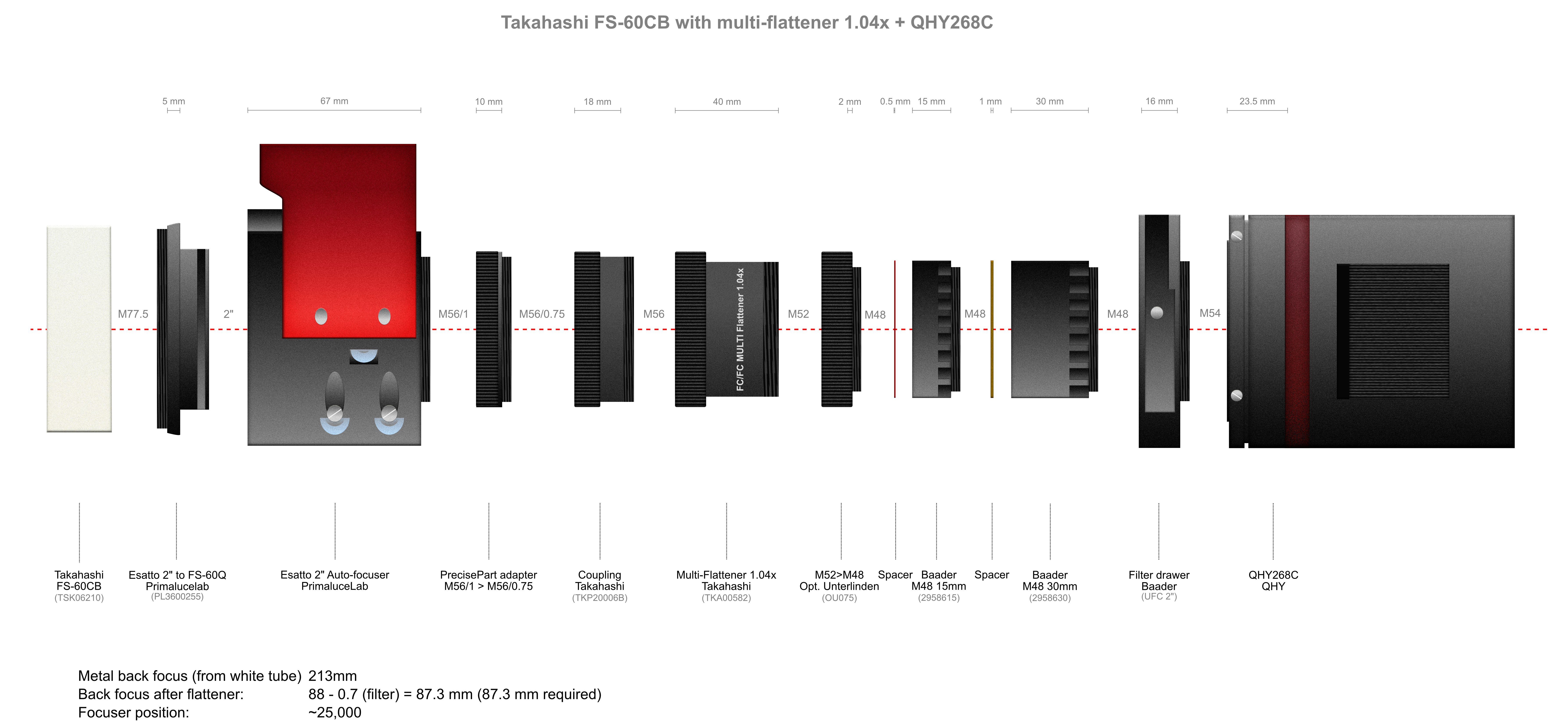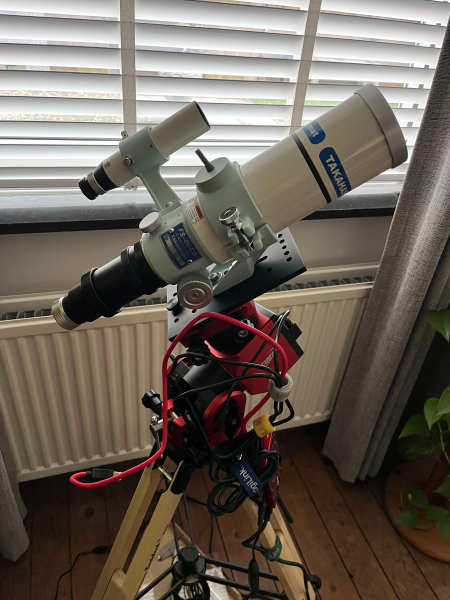With my main gear now sort of semi-fixed on rolling piers, the desire grew to have a true grab and go scope that I could take out to a dark site, the occasional star party, or on holiday. There are many options out there for small and very good scopes. But my attention was drawn to the Takahashi FS-60CB. The optical qualities of this scope are generally highly regarded, especially under visual observers. However there are not a lot of photographers out there that use this baby-Tak. I was lucky enough to get in contact with someone who used this scope for astrophotography and he was able to show some very impressive results. I was convinced it could be done, so started to put a system together.
The most-heard complaint about these small Takahashi's for photography is the focuser. It is not designed to hold kilos of camera gear without sagging a bit. So I decided to replace the stock focuser with a PrimaluceLab Esatto 2" that I had used for another project some time ago. Primalucelab sells even an adapter specifically for the FS-60CB! As a camera I decided to go for the QHY268c aps-C sized OSC camera. To go from a Primalucelab focuser to a Takahashi flattener to a Baader filter drawer to a QHY camera takes a bit of puzzling to get the connections and distances right. But the puzzle is now complete.
One of the benefits of the FS-60CB is that it is a modular system. There is a flattener, reducer and extender available. But also the objective lens can be replaced by a 76mm objective element. So that makes in total six scopes, ranging from 255mm @f/4.2 to 954mm @f12/6. It remains to be seen which of the combinations make the most sense, but to have the option to switch is nice. The newly released Askar V is doing something similar.
In the current configuration I have the multi-flattener 1.04x installed for a 370mm @f/6.2 OTA. I'm planning to add the reducer as well.
The scope rides on an RST-135E mount. This strain wave mount is extremely portable and has good performance. My preference for this mount is to not load it up with too heavy scopes or it can quickly become a bit unstable. This travel scope however sits extremely comfortable on this little mount.
During a first light session there were still a couple of issues to be worked out, but I was able to get half an hour exposure of the Eagle Nebula. Even without flat calibration I was pleased with this initial result: https://www.astrobin.com/8dl7vg/
The distances were not completely correct though, so I changed some of the adapters to get the backfocus better dialed in. This is the star field in a 60s exposure a few days later (for a full-resolution version, see here):
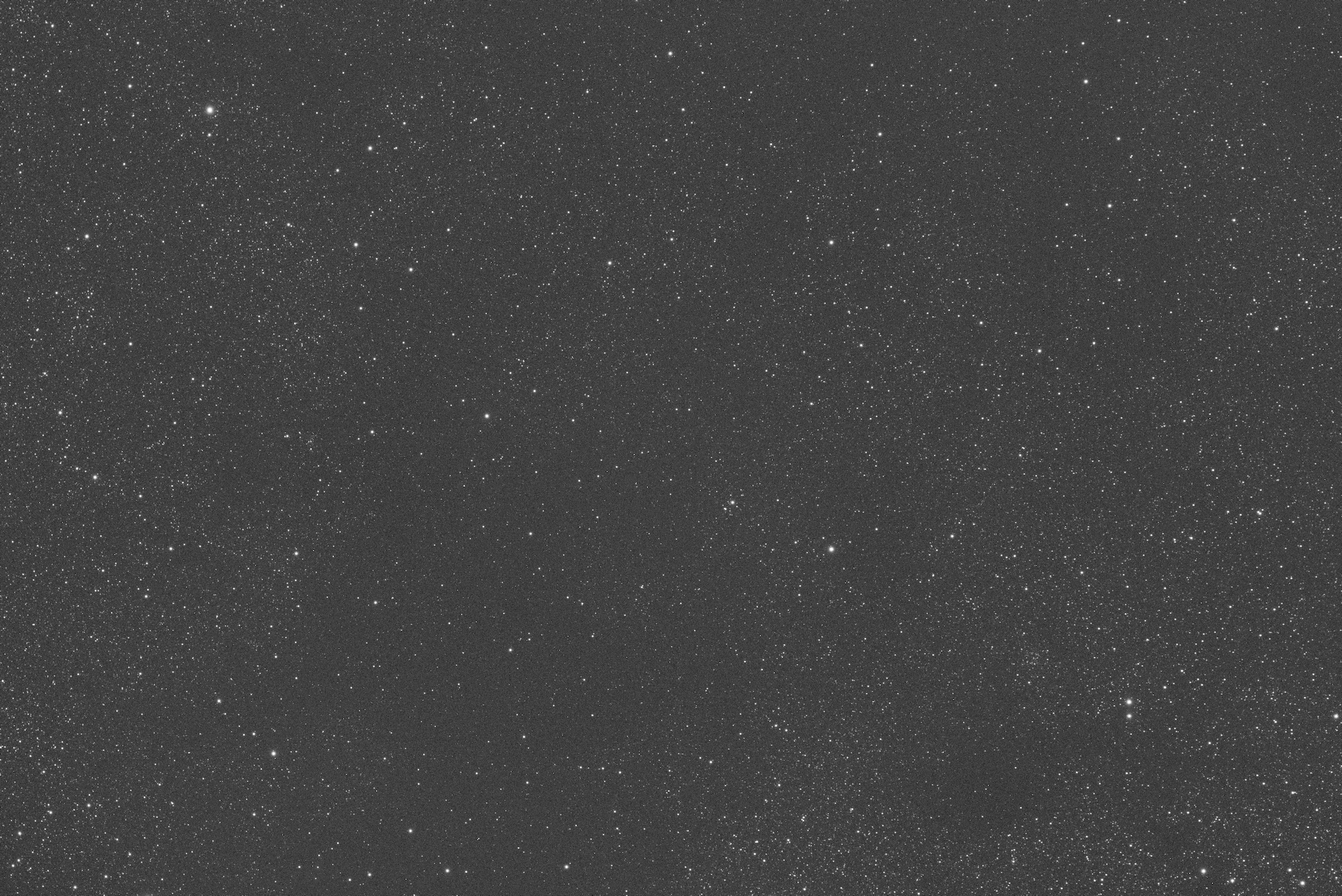
The image field was pretty flat and stars were round with a mean Eccentricity value of 0.47. No signs of strange aberrations, astigmatism, coma, etc. The camera is APS-C though, so not the most demanding. Theoretically the system should support a full frame camera as well. It remains to be seen how the system performs on full frame though.

Guiding was done using an Askar FMA180 with ASI290MM camera. Tracking worked well with RMS values typically in the range of 0.6-0.7" for RA and 0.4" for DEC.
I'm powering the whole rig with USB-Power Delivery. A simple wall charger with four USB-PD ports is enough for the whole rig and can be used at home on the mains power as well as in the field on an GoalZero power station.
This is how the setup looks in detail:

And this is the whole setup, on top of a Gitzo carbon tripod in the setup as it can be taken into the field:
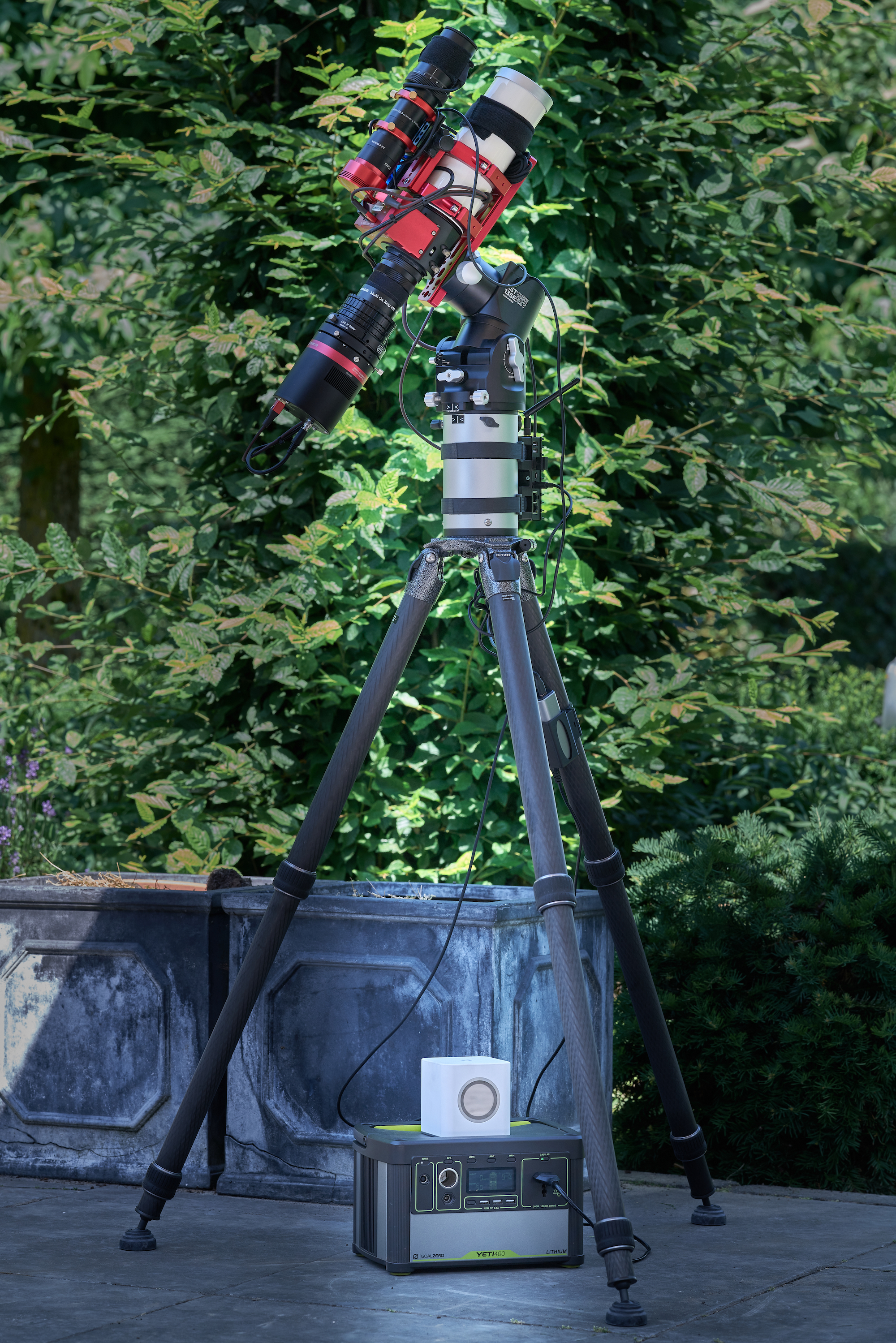
Initial experience is good. It is light, compact and easy to setup. The first results suggest a high optical quality. A variety of optical aids and the option to even put full frame cameras on it make it at least in theory a very versatile setup. I'm looking forward to take this little rig to some nice places and further explore its possibilities.
The most-heard complaint about these small Takahashi's for photography is the focuser. It is not designed to hold kilos of camera gear without sagging a bit. So I decided to replace the stock focuser with a PrimaluceLab Esatto 2" that I had used for another project some time ago. Primalucelab sells even an adapter specifically for the FS-60CB! As a camera I decided to go for the QHY268c aps-C sized OSC camera. To go from a Primalucelab focuser to a Takahashi flattener to a Baader filter drawer to a QHY camera takes a bit of puzzling to get the connections and distances right. But the puzzle is now complete.
One of the benefits of the FS-60CB is that it is a modular system. There is a flattener, reducer and extender available. But also the objective lens can be replaced by a 76mm objective element. So that makes in total six scopes, ranging from 255mm @f/4.2 to 954mm @f12/6. It remains to be seen which of the combinations make the most sense, but to have the option to switch is nice. The newly released Askar V is doing something similar.
In the current configuration I have the multi-flattener 1.04x installed for a 370mm @f/6.2 OTA. I'm planning to add the reducer as well.
The scope rides on an RST-135E mount. This strain wave mount is extremely portable and has good performance. My preference for this mount is to not load it up with too heavy scopes or it can quickly become a bit unstable. This travel scope however sits extremely comfortable on this little mount.
During a first light session there were still a couple of issues to be worked out, but I was able to get half an hour exposure of the Eagle Nebula. Even without flat calibration I was pleased with this initial result: https://www.astrobin.com/8dl7vg/
The distances were not completely correct though, so I changed some of the adapters to get the backfocus better dialed in. This is the star field in a 60s exposure a few days later (for a full-resolution version, see here):

The image field was pretty flat and stars were round with a mean Eccentricity value of 0.47. No signs of strange aberrations, astigmatism, coma, etc. The camera is APS-C though, so not the most demanding. Theoretically the system should support a full frame camera as well. It remains to be seen how the system performs on full frame though.

Guiding was done using an Askar FMA180 with ASI290MM camera. Tracking worked well with RMS values typically in the range of 0.6-0.7" for RA and 0.4" for DEC.
I'm powering the whole rig with USB-Power Delivery. A simple wall charger with four USB-PD ports is enough for the whole rig and can be used at home on the mains power as well as in the field on an GoalZero power station.
This is how the setup looks in detail:

And this is the whole setup, on top of a Gitzo carbon tripod in the setup as it can be taken into the field:

Initial experience is good. It is light, compact and easy to setup. The first results suggest a high optical quality. A variety of optical aids and the option to even put full frame cameras on it make it at least in theory a very versatile setup. I'm looking forward to take this little rig to some nice places and further explore its possibilities.
